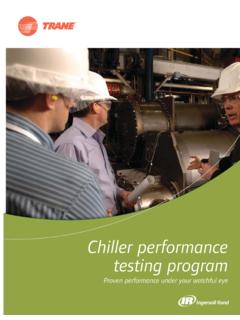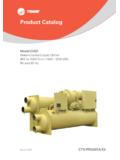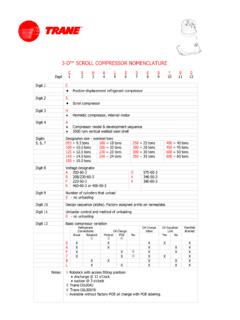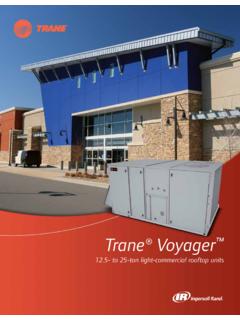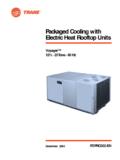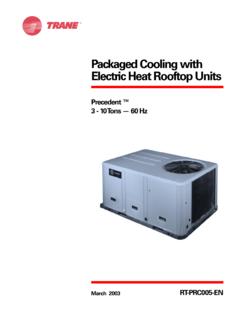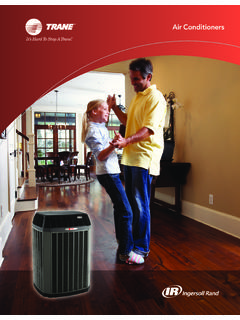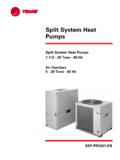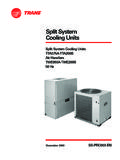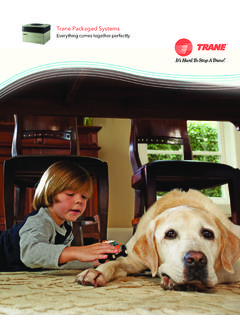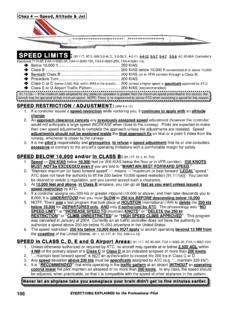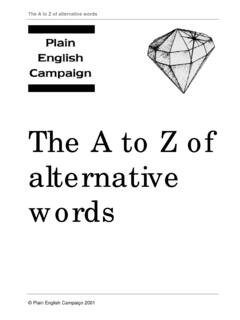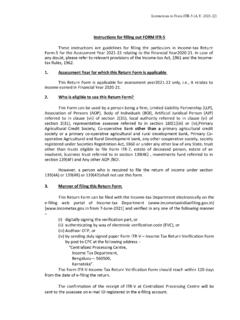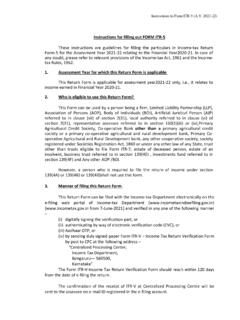Transcription of Installer's Guide - Upflow/ Horizontal, Downflow ...
1 Upflow/ Horizontal, Downflow / Horizontal, Gas-Fired, Direct Vent Condensing FurnacesALL phases of this installation must comply with NATIONAL, STATE AND LOCAL CODESIMPORTANT This Document is customer property and is to remain with this unit. Please return to service information pack upon completion of s Guide *__First letter may be A or T UPFLOW*UH1 Upflow/ HORIZONTALA341624P13*UH1*UH1B040A 9241C*UH1B060A9361C*UH1B080A9421C*UH1C08 0A9601C*UH1C100A9481C*UH1D100A9601C*UH1D 120A9601C*DH1B040A9241C*DH1B065A9421C*DH 1C085A9481C*DH1D110A9601C*DH1 DOWNFLOWDOWNFLOW/HORIZONTAL*DH118-CD29D1 -14-EN 2016 Trane All Rights Reserved 18-CD29D1-14-ENInstaller s GuideSAFETY SECTIONThe following safety practices and precautions must be followed during the installation, servicing, and opera-tion of this Use only with the type of gas approved for this furnace.
2 Refer to the furnace rating Install this furnace only in a location and position as specified in Location and Clearances (page 4), of these Provide adequate combustion and ventilation air to the furnace space as specified in Air for Combustion and Ventilation (pages 8-9), of these Combustion products must be discharged outdoors. Con-nect this furnace to an approved vent system only, as specified in the Venting section (starting on page 15), of these Never test for gas leaks with an open flame. Use a com-mercially available soap solution made specifically for the detection of leaks to check all connections, as speci-fied in Gas Piping (pages 31-32), of these Always install the furnace to operate within the furnace s intended temperature-rise range with a duct system which has an external static pressure within the al-lowable range, as specified on the unit rating plate.
3 Airflow with temperature rise for cfm versus static is shown in the Service Facts accompanying this When a furnace is installed so that supply ducts carry air circulated by the furnace to areas outside the space containing the furnace, the return air shall also be handled by a duct(s) sealed to the furnace casing and terminating outside the space containing the A gas-fired furnace for installation in a residential garage must be installed as specified in Location and Clear-ances section (page 4), of these instructions. WARNING!CARBON MONOXIDE POISONING HAZARDF ailure to follow the steps outlined below for each ap-pliance connected to the venting system being placed into operation could result in carbon monoxide poi-soning or following steps shall be followed for each appli-ance connected to the venting system being placed into operation, while all other appliances connected to the venting system are not in operation: 1.
4 Seal any unused openings in the venting system. 2. Inspect the venting system for proper size and hor-izontal pitch, as required in the National Fuel Gas Code, ANSI 54 or the CAN/CGA B149 Installation Codes and these instructions. Deter-mine that there is no blockage or restriction, leak-age, corrosion and other deficiencies which could cause an unsafe condition. 3. As far as practical, close all building doors and windows and all doors between the space in which the appliance(s) connected to the venting system are located and other deficiencies which could cause an unsafe condition. 4. Close fireplace dampers. 5. Turn on clothes dryers and any appliance not con-nected to the venting system. Turn on any ex-haust fans, such as range hoods and bathroom ex-hausts, so they are operating at maximum speed .
5 Do not operate a summer exhaust fan. 6. Follow the lighting instructions. Place the appli-ance being inspected into operation. Adjust the thermostat so appliance is operating continuously. 7. If improper venting is observed during any of the above tests, the venting system must be corrected in accordance with the National Fuel Gas Code, ANSI 54 and/or CAN/CGA In-stallation Codes. 8. After it has been determined that each appliance connected to the venting system properly vents where tested as outlined above, return doors, win-dows, exhaust fans, fireplace dampers and any other gas-fired burning appliance to their previous conditions of The furnace may be used for temporary heating of build-ings or structures under construction only when the following conditions have been met:a.
6 The furnace venting system must be complete and installed per manufacturers The furnace is controlled only by a room ther-mostat (no field jumpers).c. The furnace return air duct must be complete and sealed to the furnace and clean air filters are in The furnace input rate and temperature rise must be verified to be within nameplate 100% of the furnace combustion air require-ment must come from outside the signal words are used to designate a degree or level of seriousness associated with a particular haz-ard. The signal words for safety markings are WARN-ING and CAUTION. a. WARNING indicates a potentially hazardous situa-tion which, if not avoided, could result in death or serious injury.
7 B. CAUTION indicates a potentially hazardous situa-tion which, if not avoided, may result in minor or moderate injury. It is also used to alert against un-safe practices and hazards involving only property 3 Installer s GuideINSTALLATION INSTRUCTIONSG eneral Installation Instructions 3 Location and Clearances 4 Outline Drawings 5 Upflow Installation 7 Downflow Installation 7 Horizontal Installation 7 Air For Combustion and Ventilation 8 Duct Connections 10 Return Air Filters 11 General Venting Instructions 15 Venting Material 17 Venting Tables 18 Horizontal Venting 21 Venting Through The Wall 21 Venting Through The Roof 22 Downward Venting 24 Venting Through a Masonry Chimney 24 Condensate Drain Instructions 27 Electrical
8 Connections 30 Field Wiring Diagrams 29 Gas Piping 32 Combustion Input Checks 33 Start Up and Adjustment 36 Preliminary Inspections 36 Lighting Instructions 36 Sequence Of Operation 37 Control And Safety Switch Adjustments 37 Airflow Adjustment 37 Abnormal Conditions 38 IFC Error Flash Code 40 GENERAL INSTALLATION INSTRUCTIONS NOTE: Air leakage les than 2% of design airflow rate in accordance with ASHRAE manufacturer assumes no responsibility for equip-ment installed in violation of any code or is recommended that Manual J of the Air Condition-ing Contractors Association (ACCA) or 230 be followed in estimating heating requirements. When estimating heating requirements for installation at altitudes above 2000 ft., remember the gas input may need to be reduced (See High Altitude Installation).
9 Material in this shipment has been inspected at the factory and released to the transportation agency without known damage. Inspect exterior of carton for evidence of rough handling in ship-ment. Unpack carefully after moving equipment to approximate location. If damage to contents is found, report the damage immediately to the de-livering and local utility requirements governing the installation of gas fired equipment, wiring, plumb-ing, and flue connections must be adhered to. In the absence of local codes, the installation must conform with latest edition of the National Fuel Gas Code ANSI National Installation Code, CAN/CGA The latest code may be obtained from the American Gas Association Laboratories, 400 N. Capitol St. NW, Washington 20001.
10 1-800-699-9277 or furnaces have been classified as CATEGORY IV furnaces in accordance with latest edition of ANSI CAN/ CGA IV furnaces operate with positive vent stat-ic pressure and with a flue loss less than 17 percent. These conditions require special venting systems, Contents WARNING!FIRE OR EXPLOSION HAZARDF ailure to follow the safety warnings exactly could result in serious injury, death or property damage. Improper servicing could result in dangerous opera-tion, serious injury, death, or property must be gas tight and water tight. These Cate-gory IV Direct Vent furnaces are approved for installa-tion in Manufactured/ Mobile housing when used with BAYMFGH100A. CAUTION!To prevent shortening its service life, the furnace should not be used as a Construction Heater during the finish-ing phases of construction until the requirements listed in item 9, a-g of the safety section of this publication have been met.
